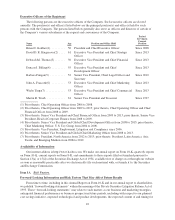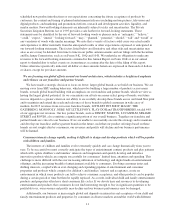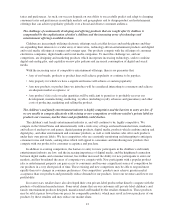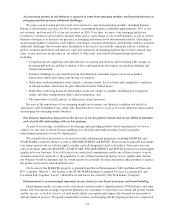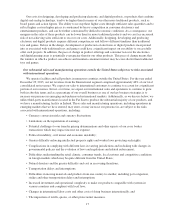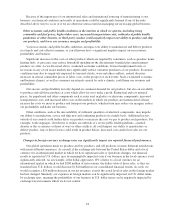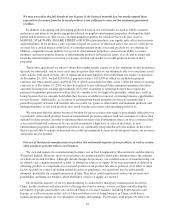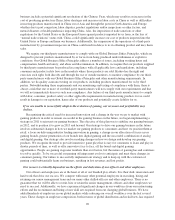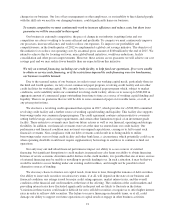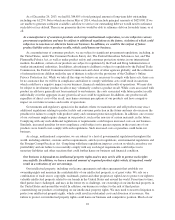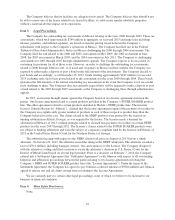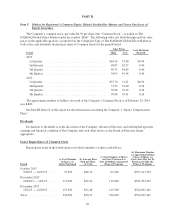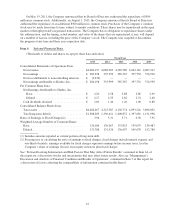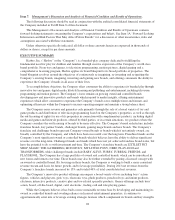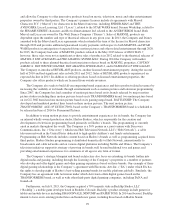Hasbro 2013 Annual Report Download - page 31
Download and view the complete annual report
Please find page 31 of the 2013 Hasbro annual report below. You can navigate through the pages in the report by either clicking on the pages listed below, or by using the keyword search tool below to find specific information within the annual report.We may not realize the full benefit of our licenses if the licensed material has less market appeal than
expected or if revenue from the licensed products is not sufficient to earn out the minimum guaranteed
royalties.
In addition to designing and developing products based on our own brands, we seek to fulfill consumer
preferences and interests by producing products based on popular entertainment properties developed by third
parties and licensed to us. The success of entertainment properties for which we have a license, such as
MARVEL, STAR WARS, SESAME STREET or ROVIO related products, can significantly affect our revenues
and profitability. If we produce a line of products based on a movie or television series, the success of the movie
or series has a critical impact on the level of consumer interest in the associated products we are offering. In
addition, competition in our industry for access to entertainment properties can lessen our ability to secure,
maintain, and renew popular licenses to entertainment products on beneficial terms, if at all, and to attract and
retain the talented employees necessary to design, develop and market successful products based on these
properties.
The license agreements we enter to obtain these rights usually require us to pay minimum royalty guarantees
that may be substantial, and in some cases may be greater than what we are ultimately able to recoup from actual
sales, which could result in write-offs of significant amounts which in turn would harm our results of operations.
At December 29, 2013, we had $294,991 of prepaid royalties, $152,459 of which are included in prepaid
expenses and other current assets and $142,532 of which are included in other assets. Under the terms of existing
contracts as of December 29, 2013, we may be required to pay additional future minimum guaranteed royalties
and other licensing fees totaling approximately $332,000. Acquiring or renewing licenses may require the
payment of minimum guaranteed royalties that we consider to be too high to be profitable, which may result in
losing licenses that we currently hold when they become available for renewal, or missing business opportunities
for new licenses. Additionally, as a licensee of entertainment-based properties we have no guaranty that a
particular property or brand will translate into successful toy, game or other family entertainment products, and
underperformance of any such products may result in reduced revenues and operating profit for us.
We anticipate that the shorter theatrical duration for movie releases may make it increasingly difficult for us
to profitably sell licensed products based on entertainment properties and may lead our customers to reduce their
demand for these products in order to minimize their inventory risk. Furthermore, there can be no assurance that
a successful brand will continue to be successful or maintain a high level of sales in the future, as new
entertainment properties and competitive products are continually being introduced to the market. In the event
that we are not able to acquire or maintain successful entertainment licenses on advantageous terms, our revenues
and profits may be harmed.
Our use of third-party manufacturers to produce the substantial majority of our products, as well as certain
other products, presents risks to our business.
We own and operate two manufacturing facilities, one in East Longmeadow, Massachusetts and the other in
Waterford, Ireland. However, most of our products are manufactured by third-party manufacturers, the majority
of which are located in China. Although, should changes be necessary, our external sources of manufacturing can
be shifted, over a significant period of time, to alternative sources of supply. If we were prevented or delayed in
obtaining products or components for a material portion of our product line due to political, civil, labor or other
factors beyond our control, including natural disasters or pandemics, our operations may be substantially
disrupted, potentially for a significant period of time. This delay could significantly reduce our revenues and
profitability and harm our business while alternative sources of supply are secured.
Given that the majority of our toy manufacturing is conducted by third-party manufacturers located in
China, health conditions and other factors affecting social and economic activity in China and affecting the
movement of people and products into and from China to our major markets, including North America and
Europe, as well as increases in the costs of labor and other costs of doing business in China, could have a
significant negative impact on our operations, revenues and earnings. Factors that could negatively affect our
19



